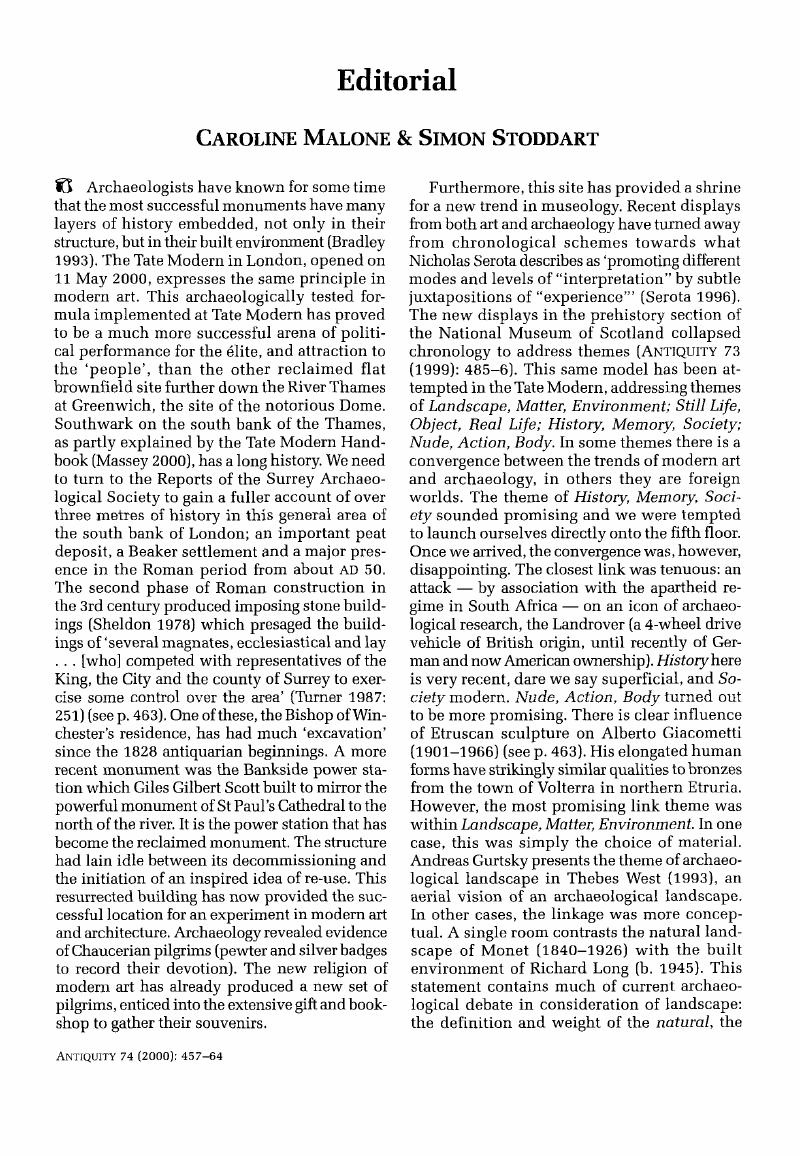No CrossRef data available.
Article contents
Editorial
Published online by Cambridge University Press: 02 January 2015
Abstract
An abstract is not available for this content so a preview has been provided. As you have access to this content, a full PDF is available via the ‘Save PDF’ action button.

- Type
- Editorial
- Information
- Copyright
- Copyright © Antiquity Publications Ltd. 2000
References
Barson, T., Batchelor, D.
Berkeley, K.
Freedman, C.
Gale, M.
Horlock, M.
Montagu, J.
Moszynska, A.
Wilson, A.
Wilson, S. & Withers, R.. 2000. 100 Artists A-Z, in Blazwick, I. & Wilson, S. (ed.), Tate Modern the handbook:
112–233. London: Tate Gallery Publishing.Google Scholar
Brown, N. & Glazebrook, J.. 2000. Research and archaeology: A framework of the Eastern Counties 2: Research agenda and strategy. East Anglian Archaeology.Google Scholar
Coles, A.
1999. The epic archaeological digs of Mark Dion, in Coles, & Dion, (ed.): 25–33.Google Scholar
Coles, A. & Dion, M. (ed.). 1999. Mark Dion archaeology. London: Black Dog Publishing.Google Scholar
Department of the Environment. 1990. PPGI6: Archaeology and planning. Planning Policy Guidance Circular.Google Scholar
Department of the Environment. 1994. PPG15: Planning and the Historic Environment. Planning Policy Guidance Circular.Google Scholar
English Heritage. 1991. Exploring our past: Strategies for the archaeology of England. London: English Heritage. Occasional paper 8.Google Scholar
James, S.T. & Millet, M. (ed.). In press. Britons and Romans: advancing an archaeological agenda. York: Council for British Archaeology.Google Scholar
Prehistoric Society. 1988. Saving our prehistoric heritage. A report by the Prehistoric Society. London: Prehistoric Society.Google Scholar
Prehistoric Society. 1999. Research Frameworks for the Palaeolithic and Mesolithic of Britain and Ireland. London: Prehistoric Society.Google Scholar
Renfrew, A.C.
1999. It may be art, but is it archaeology ? Science as art and art as science, in Coles, & Dion, (ed.): 12–23.Google Scholar
Rosenblum, R., Stevens, M. & Dumas, A. (ed.). 2000. 1900 Art at the Crossroads. New York (NY): Abrams.Google Scholar
Sheldon, H.
1978. The 1972–4 excavations: their contribution to Southwark’s history, in Bird, J.
Graham, A.H.
Sheldon, H. & Towsend, P. (ed.), Southwark excavations 1972–4:
11–49. London/Guildford: London & Middlesex Archaeological Society/Surrey Archaeological Society.Google Scholar
Serota, N.
1996. Experience or interpretation. The dilemma museums of modern Art. London: Thames & Hudson.Google Scholar
Stevens, M.
2000. The exposition universelle: ‘This vast competition of effort, realisation and victories’, in Rosenblum,
et al. (ed.): 55–71.Google Scholar
Tilley, C., Hamilton, S. & Bender, B.. 2000. Art and the representation of the past, Journal of the Royal Anthropological Institute
6 (1): 33–62.Google Scholar
Turner, D.J.
1987. Archaeology of Surrey, 1066–1540, in Bird, J. & Bird, D.G. (ed.), The Archaeology of Surrey to 1540:
223–61. Guildford: Surrey Archaeological Society.Google Scholar
Williams, J. & Brown, N.. 1999. An Archaeological Research Framework for the Greater Thames Estuary. Essex County Council.Google Scholar


